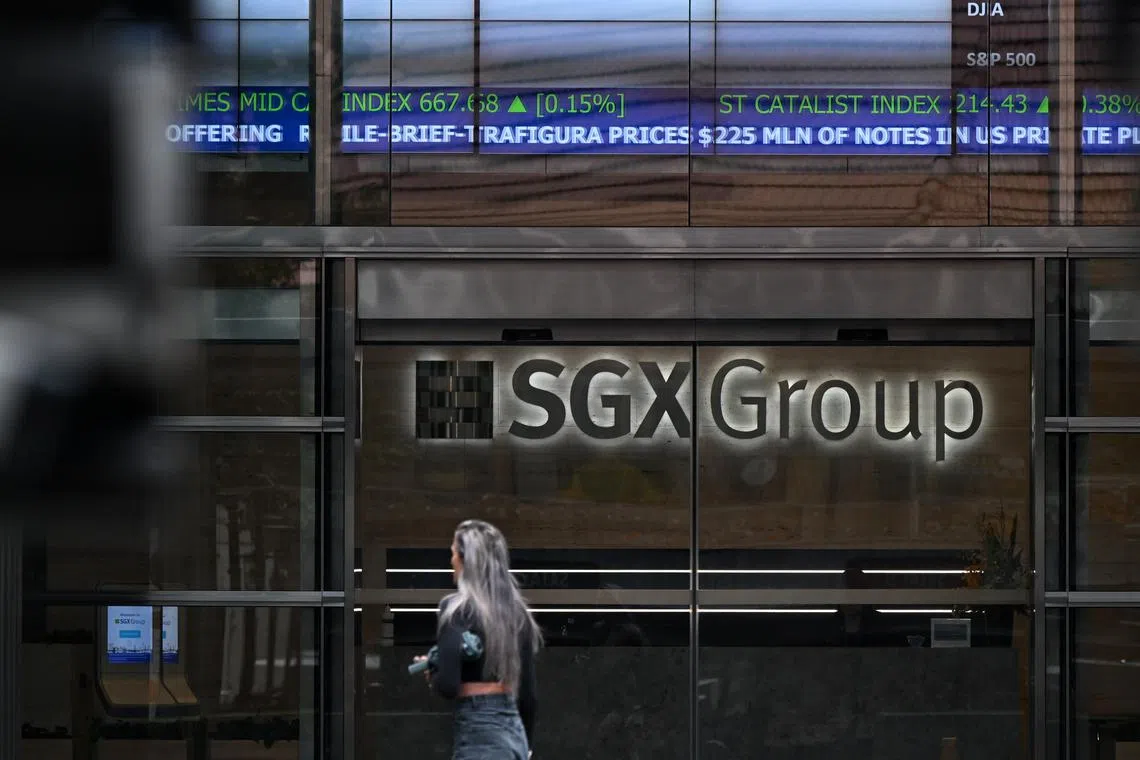Market Watch
Market gyrates between fear and hope
Sign up now: Get ST's newsletters delivered to your inbox

In Singapore, the STI slid 1.18 per cent last week, while the banks and heavyweights like Singtel and SIA posted strong quarterly and interim results.
ST PHOTO: KUA CHEE SIONG
Follow topic:
SINGAPORE – The forces of fear and hope wrestled through the week, sending markets into frenzied sessions of gains and losses, amid speculation on where interest rates and yields are headed over the next few months.
But on the whole, it was a positive week as investors homed in on oversold positions in anticipation of a potential market recovery should the Federal Reserve decide not to hike rates at its December meeting.
At the International Monetary Fund’s panel discussion last Thursday, Fed chairman Jerome Powell said the United States central bank will not hesitate to tighten more if needed.
“We know that ongoing progress towards our 2 per cent goal is not assured: Inflation has given us a few head fakes,” Mr Powell said in Washington. “If it becomes appropriate to tighten policy further, we will not hesitate to do so.”
The mere possibility of a rate hike introduces volatility as every new data point has the potential to alter market dynamics.
But Mr Powell probably said what he said to push back on expectations, which have changed sharply in the past two weeks as Treasury yields tumbled and markets started focusing on rate cuts even though the Fed has said it is not even contemplating this for now.
Despite the chairman trying to sound hawkish, the market still interpreted his comments as tacit confirmation that rate hikes are largely done. This was further reinforced by a series of soft data releases, culminating in an employment report with a cooler-than-expected headline figure.
On Wall Street, the Dow Jones Industrial Index ended 0.65 per cent higher at 34,283.10 points.
The S&P 500 was up 1.31 per cent, thanks largely to the so-called “Magnificent Seven” tech/new age stocks: Alphabet, Amazon, Apple, Meta, Microsoft, Nvidia and Tesla. The tech-heavy Nasdaq was up 2.37 per cent for the week to 13,798.11 points.
In Singapore, the Straits Times Index slid 1.18 per cent during the week, while the banks and heavyweights like Singtel and Singapore Airlines (SIA) posted strong quarterly and interim results.
The trio of local banks achieved record total income in the third quarter as net interest income continued to expand from higher rates, and growth in non-interest income was sustained.
Given their performance and market heft, it is no surprise that DBS Bank, UOB and OCBC Bank have remained the three most traded Singapore stocks on a day-to-day basis, with around 25 cents in every dollar put into the Singapore stock market every day directed to the trio.
Meanwhile, SIA continued to soar, posting another set of record earnings as demand for travel and added capacity boosted the airline’s bottom line.
One particularly interesting set of results was that of aviation services company Sats, whose first-half loss narrowed sharply to $7.8 million amid a recovery in the global aviation industry. The company’s financials had been weighed down by consolidation costs following its purchase of European aviation services giant Worldwide Flight Services earlier in 2023. For the second quarter of its financial year, the mainboard-listed group delivered $22.2 million in net profit – its first earnings without government relief since the pandemic struck in early 2020. It had recorded a net loss of $29.9 million for the first quarter.
So what next for the market?
In a Nov 6 Global Investment Committee (GIO) strategy bulletin, Citi Global Wealth said this could be a turning point for the market. It noted that inflation is coming down; employment growth is slowing; corporate profits are rebounding; expectations for global growth are modest; wage growth is moderating; equity valuations are reasonable; the high short-term rates of today will not be available (in risk-free investments) tomorrow; and the economy looked more resilient than expected.
“On Oct 18, the GIO raised the allocation to global equities from neutral to overweight,” it said. “This is our first such move since early 2020. We did this in the face of falling share prices. The evolving macro environment suggests that equity price appreciation will broaden in the US, then globally.”
That said, it is important to have a diversified portfolio strategy.
Almost half of the S&P 500’s gains – and volatility – of the past year have been on the back of the Magnificent Seven. These stocks have posted gains of between 7 per cent and 18 per cent in a very short space of time since the start of November.
As the Economist newspaper pointed out recently, if one were to remove them, the remaining “S&P 493” – which includes diverse companies such as billionaire Warren Buffet’s investment firm Berkshire Hathaway, pharmaceutical giant Eli Lilly and financial heavyweight JP Morgan Chase – has been somewhat flattish and, more importantly, stable.
Going forward, market volatility will likely follow yield volatility, even after the Fed is done with rate hikes.
As experts like Mr Mohamed El-Erian, former chief executive of global investment management firm Pimco and current president of Queen’s College, noted, bond yields could still remain high amid US government bond issuance to finance the widening deficit and refinance maturing debt at higher rates.
So while the key 10-year Treasury bond yield has pulled back somewhat, providing the tailwind for markets in November, investors should continue to watch the yield space closely.
On the topic of debt and yield, another major event that could impact the markets in the coming weeks is the possibility of a US government shutdown.
The US government is funded up till Nov 17, but the Democratic-led Senate and the Republican-controlled House have yet to come to an agreement on how to keep government agencies operating past that date. Markets seem unfazed even though the deadline is only a few days away, because investors are probably hoping for a stopgap measure to extend government funding.
The million-dollar question is, what should investors do, given all the uncertainties that markets are facing?
Mr Vasu Menon, managing director for investment strategy at OCBC, advises adopting a defensive posture, but with a view to a potential market recovery in 2024.
“Staying out of the markets altogether to seek shelter in cash does not make sense,” he said. “It makes sense to stay invested but what’s important is to invest gradually, carefully and selectively, instead of timing the markets and taking concentrated bets.”
Meanwhile, with rates at 22-year highs (the Fed funds rate is now at the 5.25 per cent to 5.5 per cent range), the big question is how long the US Fed can sustain these levels without damaging the economy. The implication of elevated rates on consumers and businesses should not be underestimated. If they feel the pinch and cut back, there could be sequential – and painful – economic contraction next year.
That said, the medium-term outlook is more promising. Bond yields could eventually fall in 2024 if inflation cools meaningfully due to a recession or sharp economic slowdown in the US. In such an instance, the Fed could pivot to a dovish stance and even cut rates, which has historically been good for equity and bond markets.
Indeed, a significant portion of the US$6.6 trillion (S$9 trillion) parked in risk-free money market funds could return to equities if yields slide in 2024.
US consumer price inflation data for October will be in the spotlight this week, along with US retail sales, given that consumer spending accounts for two-thirds of the US economy.
Expectations are for a moderation in headline inflation, given the decline in petrol prices, but the outlook for core inflation appears more mixed and this could have a marked impact on market expectations over whether the Fed tightening cycle has indeed finished.
Also, US retail sales are expected to weaken following a long period of upside surprises from US consumers as pandemic-induced excess savings dry up.


